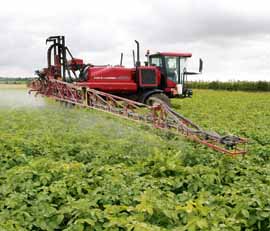Blight resistance variety ratings lowered

Late blight resistance ratings for the majority of potato varieties previously rated at five or above have been downgraded after trials showed they were more susceptible to the dominant 13_A2 blight strain in the UK.
Anecdotal evidence had suggested some varieties were more susceptible to the current blight population than their historic resistance rating would suggest, Alison Lees of the Scottish Crops Research Institute told the Potato Council‘s winter forum.
So varieties with a resistance rating of five or higher have been re-evaluated in a three-year programme of testing against the 13_A2 blight strain by SASA, SCRI, SAC and the Savari Research Trust, partly funded by the Potato Council.
The testing revealed a number of significant shifts in the ratings for some existing varieties, including the downgrading of Lady Balfour from an eight, Sante from a seven and Nadine from a six – all now rated four.
In total, 32 varieties have had their rating adjusted by two or more points, with the vast majority now being rated at between three and five. Only two varieties, Harmony and Pentland Ivory, have had their resistance rating increased.
Varieties that were previously rated at four or below have not had their rating adjusted, as the decision was taken not to retest those varieties because they were already considered to be susceptible, Dr Lees said.
Despite the narrowing of the range of ratings, late blight varietal resistance did still have an important part to play in integrated control strategies, Ruairidh Bain of SAC insisted.
“While the ratings are accurate, I think we are underestimating the influence of varietal resistance.”
Differences in resistance between some varieties could be undervalued in small plot trials ratings, he explained.
He pointed to trials showing the difference between varieties in blight susceptibility in four and 48 plant variety tests. “Typically the difference in blight levels between varieties is much smaller in the four plant trials.”
That suggested variety trials could be underestimating the differences between varieties at a field scale, he reckoned. “There are still substantial differences in foliar blight resistance between many varieties.”
Previous research had also suggested that a difference in just one point in resistance rating could make a big difference in the amount of blight in crops, he added.
Differences in varietal blight resistance could be exploited within integrated control strategies, as shown in a DEFRA and RERAD-funded LINK project.
Those trials suggested in the majority of cases there was better blight control in a resistant variety sprayed with less fungicide compared with a susceptible variety (King Edward) sprayed with the strongest blight product.
“Integrated control of blight based on variety resistance has demonstrated considerable promise under high risk conditions,” he said. “And it could be even better under the lower risk conditions more typical of commercial crops.”
Blight varieties
Varieties more susceptible to dominant blight strain
Changes in blight resistance ratings
32 varieties changed by two or more points
For more information click here

